
Women in the fish industry and at the fish market, 2015
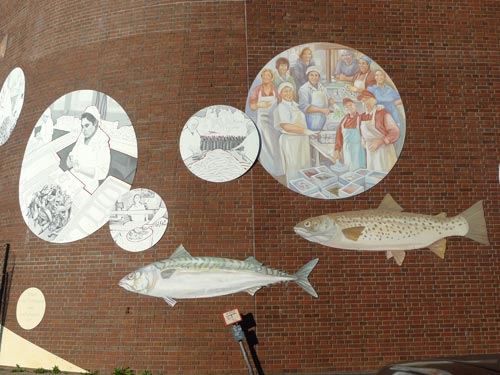
"Women in the fish industry and at the fish market"
Große Elbstraße 264 - 268, circular retaining wall.
Design and realization: Hildegund Schuster, Cecilia Herrero.
Curator: Elisabeth von Dücker. Sponsors: Altona District.
Photo: Hildegund Schuster ©
A lively party is held on the sunny afternoon of 28 August to celebrate the inauguration of the new mural in the FrauenFreiluftGalerie Hamburg (Women’s Open Air Gallery), with about 150 guests gathering at the western end of the fish market in front of the 400 sm mural entitled "Women in the fish industry and at the fish market". Many of them were among the "live sources" whose interviews had made a contribution to the mural with insights into their personal work history.
Some of them were women from the first generation of migrant workers from Mediterranean countries such as Turkey who had come to Germany and earned their living as fish workers here in Altona. The guests also included a few female company directors

Inscription sign
who had taken over the family business at the fish market from their fathers. They all found themselves on the circular picture elements painted by artists Hildegund Schuster from Hamburg and Cecilia Herrero from Argentina.
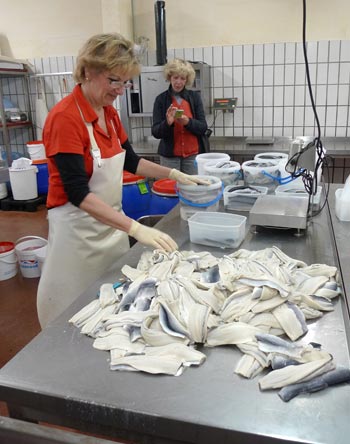
Elisabeth von Dücker interviews Marina
who is pickling herring. 2015.
Photo: Hildegund Schuster ©
The curator’s research revealed one positive aspect that has remained practically unnoticed hitherto: the fish market is becoming increasingly feminised! The traditionally patriarchal management structures in the companies working here are being increasingly replaced by a generation of daughters. In specific terms, this means that female job qualifications are improving with a more positive working climate: the conventional picture of the fish market as a "man’s world" is starting to crumble in another step towards society’s objective of gender equality.
Indeed, this local development is also reflected in Germany’s economy as a whole: one in five SME companies in Germany is run by a woman, according to the results of a study published in July 2015.(1)
Located at the fish market with all its rich traditions nestling here against the bank of the river Elbe, the new mural illustrates how the fish sector as a local economic factor has changed in significance in the course of industrialisation. At the same time, it visualises the still very manual nature of work involved in the fish industry, work which is frequently performed by women.
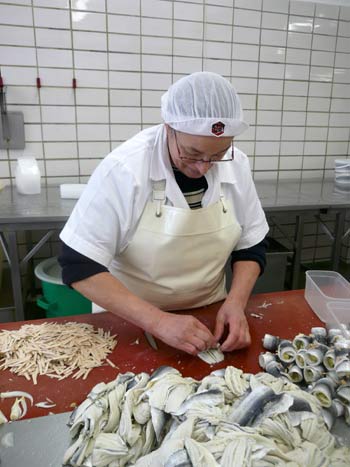
Maria rolling a rollmops. 2013.
Photo: Elisabeth von Dücker ©
Women do lots of jobs at the fish market. In leading roles as junior executives or managing directors in the fish wholesale and retail trade; processing and frying fish or rolling rollmops in the fish factory; dispatch managers, office clerks or sales staff; restaurant managers or waitresses; also as public veterinarians and even as specialists for good working conditions at the Food, Beverages and Catering Industry Trade Union (NGG) - who would have thought that women would be involved to such an extent in keeping companies working or even deciding how they are run down here in the port which is so frequently perceived to be a "man’s world"?
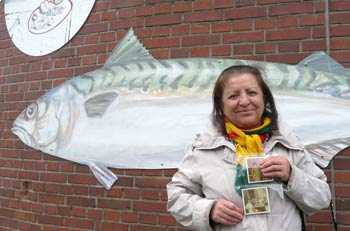
Hamide shows photos from the period when she
was a fish worker in Altona in 1975. 2015.
Photo: Reinhardt Reimer ©
Despite increasing improvements and labour-saving innovations, working in the fish processing factories behind the old fish market walls is often seen as a hard job, particularly in the winter months: extensively manual labour, working hours that frequently start at midnight at room temperatures of only approx. +2 degrees, "iced" fish(2), standing for hours on end with damp fingers and cold feet, frequently up to their elbows in grease or blood doing jobs often perceived as "dirty", such as slaughtering eels, for example. Some of the working rooms are damp, wet and draughty because the raw material is so sensitive to heat. "Expecting workers to labour in wet and cold conditions and at night is simply unreasonable", summarises the fish market veterinarian.(3)
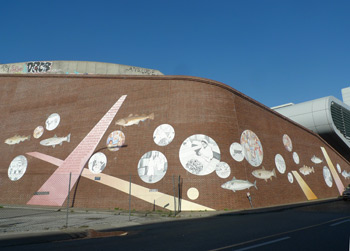
Full view. 2015.
Photo: Hildegund Schuster ©
The new mural was painted by the artists Hildegund Schuster, Hamburg, and Cecilia Herrero, Argentina, and designed by Hildegund Schuster. It can be found in the west of the fish market on a red brick wall covering approx. 400 sm with a height of between 5 and 11 m. There are seventeen circular tondi (approx. 2.5 to 1 m in diameter), four long strips featuring definitions describing what it's like to work in the fish market and quotations from interviews (approx. 4 to 12 m), together with eight fish about three metres long: cod, mackerel, sea trout, and the bass as the only fresh water fish in this swarm, all painted by Cecilia Herrero.
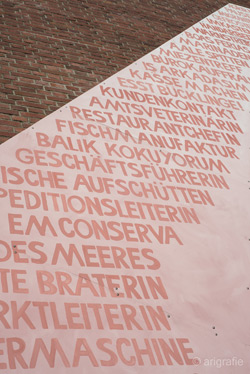
Word strips, excerpt. 2015.
Photo: arigrafie.de ©
The tondi show women working in the fish market today and various jobs that fish workers did in the past, with motifs going back to the 1890s. The pictures are based on photographs, translated by Hildegund Schuster. into paintings with a realistic design language using grey and white shades. A dark red line accentuates rooms, figures and work processes.

Excerpt: large tondo:
Pickling fish in cans. 2015.
Photo: Klaus Schlegel ©
It becomes clear how many work processes in the fish industry are still done by female hand today, as was already the case right back at the turn of the 20th century. Examples include rolling rollmops, slaughtering eels, putting fish on metal spits for smoking, taking the smoked fish off the spits again and then packing them, pickling fish in cans or drums, frying fish, mixing proprietary recipes for sauces and stirring the mixtures by hand, making salads and much more besides.
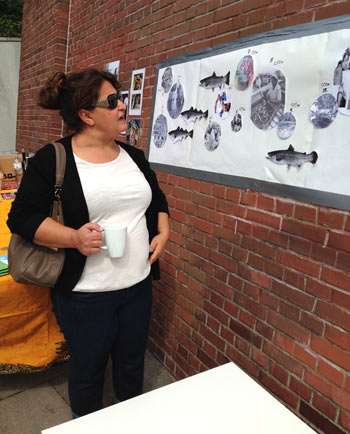
Ummahan in front of designs for the mural
during the inauguration. 2015.
Photo: Elisabeth von Dücker ©
It is the artistic, documentary approach that makes the entire open air project stand out. This mural too is based on what women have had to say about their working lives, according to interviews conducted during 2015 as well as historical picture and text sources. Altogether 25 women talked about their jobs, their role in a port-oriented working world, their opinion about the so-called work/life balance and what they would wish for in a satisfactory working environment.(4)
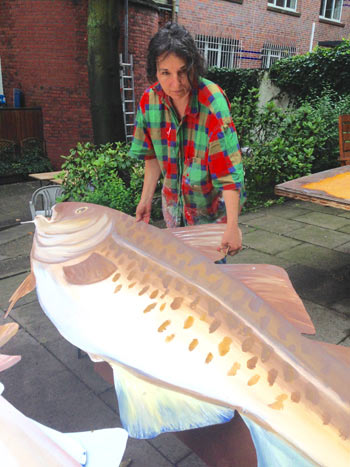
Cecilia Herrero in the "garden studio"
at the Seamen’s Mission. 2015.
Photo: Elisabeth von Dücker ©
The coloured scenes were created by Cecilia Herrero, with four tondi featuring portraits from different areas such as processing, organisation or management. The pulsating colours of her palette give an indication on the one hand of her artistic roots in Mexican mural painting. On the other hand, they give her figures a lively "speaking" presence, reflecting one of the central intentions of the Open Air Gallery which is to make the traces visible.(5)
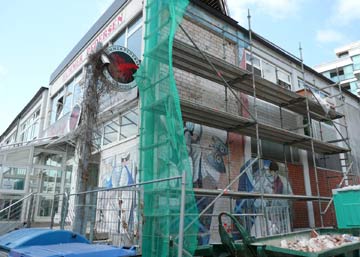
Demolition of the old fish mural
at Hummer Pedersen.2013.
Photo: Elisabeth von Dücker ©
The mural was painted on composite aluminium panels(6) rather than directly on the red brick wall, to meet a demand made by the private owners of the Elbbergcamus complex.
Following eighteen months of preparations with interviews, scientific research and fund-raising, the search for a suitable wall in the fish market proved to be a real supplicant’s obstacle course. Approval then came literally at the last minute to use the brick wall at the west end of the fish market, which in itself is a local icon in terms of railway history: its sweeping curve forms the retaining wall of what was North Germany’s first railway bridge. It is also part of early fishing history, vaulting over the former "fish railway" that connected all the fishing businesses with the railway station in Altona.(7)
The currently youngest mural in the Open Air Gallery on the banks of the river Elbe replaces and updates its predecessor from 1994. This first mural in the Open Air Gallery disappeared in 2014 during the conversion work to the Hummer Petersen building at the eastern entrance to the fish market, see
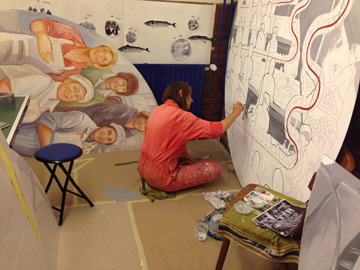
Hildegund Schuster in the "basement studio",
Seamen’s Mission. 2015
Photo: Elisabeth von Dücker ©
Fortunately, the artists were able to use the garden and a basement at the Seamen’s Mission Altona as their studio, as was already the case with the previous mural "Working Women in the Ports of New York and Hamburg - a Bridging Project".
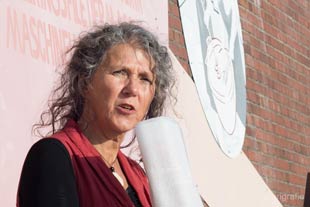
Reading by Ulrike Johannson. 2015.
Photo: arigrafie.de ©
Reference to the "many voices" of this mural could also be found in the reading "all about fish" by actress Ulrike Johannson during the inauguration. The reading was a collage of texts reflecting the women working in different areas at the fish market, right across generations, nationalities and social contexts.(8)
The port as a man’s world - myth or reality?
Here are a couple of figures to be going on with: "A good half of the roughly 800 employees working for Fischmarkt Hamburg-Altona GmbH in and around Hamburg’s fishing port are women."(9)
A kind of provisional initial conclusion about working in the fishing industry at the fish market comes from some of the women working here: "Unfortunately, the fish market is almost completely run by men", says a female wholesale trader and company boss who "had" to step into her father’s shoes at the tender age of twenty in 1987. And the female boss of a company based in the fish market for four generations says: "It’s not easy for women: it’s a man’s world here, but it’s the women who pull the strings in the background". She kept her maiden name even after getting married to "keep the traditions in the family company" – would her great-grandfather have approved? And an office worker in a fish delicatessen in the fish market, who is the only woman in her company, says: "Today the women are as good as the men".
© Elisabeth von Dücker, 2015
(1) Although medium-sized companies run by women play a significant role in the economy, female bosses are still under-represented in the German SME sector. This is the main result of a current study by KfW Research based on the KfW SME panel. Press release dated 28/07/2015 / KfW Group
(2) ced fish are covered with crushed ice.
(3) Dr. A. Höfer, public veterinarian District Office Altona (interviewed by E. von Dücker, 26/05/2015).
(4) The taped interviews were based on a standard questionnaire and were conducted with 17 respondents from Germany and 6 from Europe, including Portugal, Turkey, Ukraine.
(5) Annika Meier and Katharina Moll helped to paint the word and interview strips with their handicraft skills. In 2012 they had been involved as schoolgirls in the mural on the career prospects for young women on the port "Girls in view - their future in the port" teilgenommen
(6) So-called neobond boards
(7) cf. Elisabeth von Dücker "Altona Port Railway. Where fish go through the tunnel", in: "Look here. District Tours" published by Hamburg Department of Culture, Hamburg 1998, p. 301-305.
(8) The texts were based on interviews conducted by the curator, arranged by the actress.
(9) Information provided by the company CEO Matthias Funk, 25/09/2015.
Picture gallery
1. Research and interviews | 2. Designs | 3. Painting | 4. Transport and installation | 5. Inauguration | 6. Close-ups
1. Research and interviews
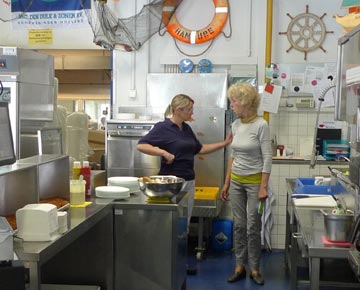
Elisabeth von Dücker interviews Tetyana from Wilhelm Goedeken (company). 2015. Photo: Hildegund Schuster ©
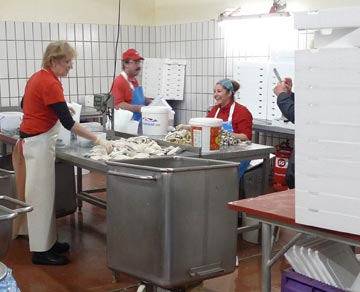
Nazli and Marina processing fish. 2015.
Photo: Hildegund Schuster ©
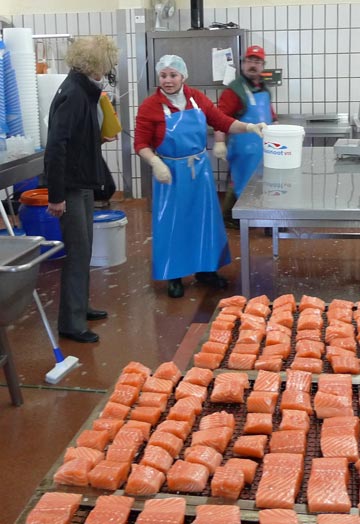
Elisabeth von Dücker interviews Nazli. 2015.
Photo: Hildegund Schuster ©
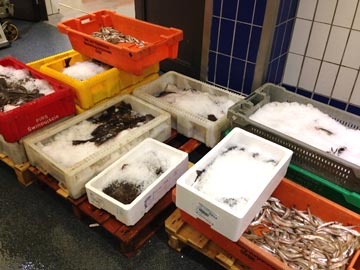
6 o’clock in the morning at the fish market. 2015.
Photo: Elisabeth von Dücker ©
back to the start of the picture gallery
2. Designs
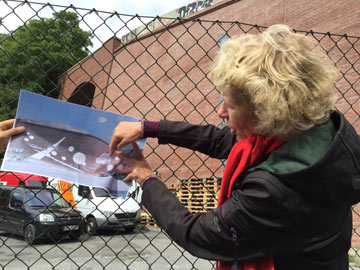
Discussing the designs on the spot. 2015.
Photo: Kostja Bogatyrev ©
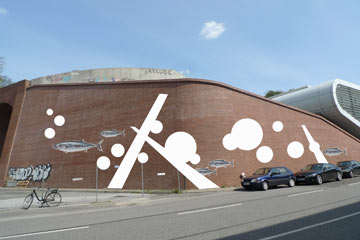
First design. 2015.
Photo: Hildegund Schuster ©
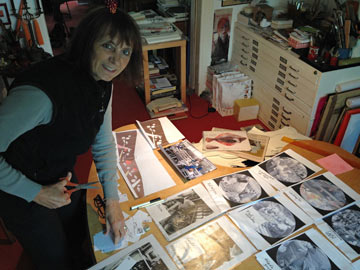
Hildegund Schuster developing the designs. 2015.
Photo: Elisabeth von Dücker ©
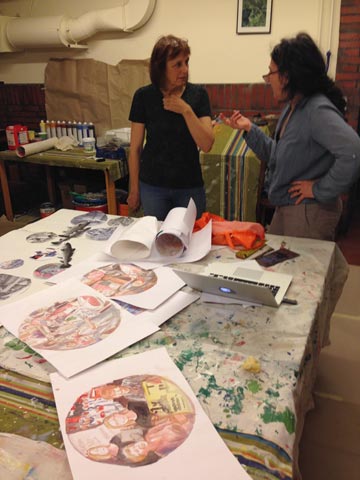
Hildegund Schuster and Cecilia Herrero in the basement studio, Seamen’s Mission. 2015.
Photo: Elisabeth von Dücker ©
back to the start of the picture gallery
3. Painting
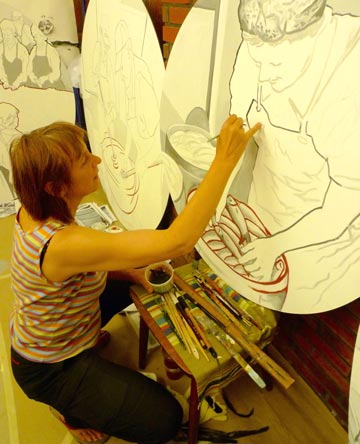
Hildegund Schuster. 2015.
Photo: Elisabeth von Dücker ©
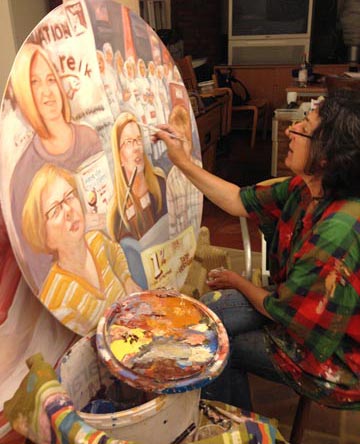
Cecilia Herrero. 2015.
Photo: Elisabeth von Dücker ©
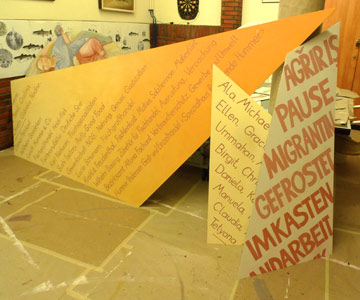
Word strips in the studio. 2015.
Photo: Hildegund Schuster ©
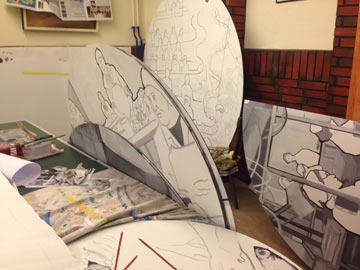
View inside the basement studio. 2015.
Photo: Hildegund Schuster ©
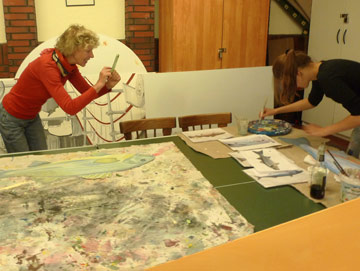
Taking photos for the record in the studio. 2015.
Photo: Hildegund Schuster ©
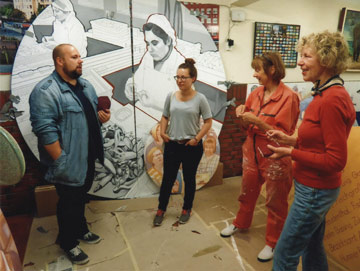
Taking photos for the record in the studio. 2015.
Photo: Günter Zint ©
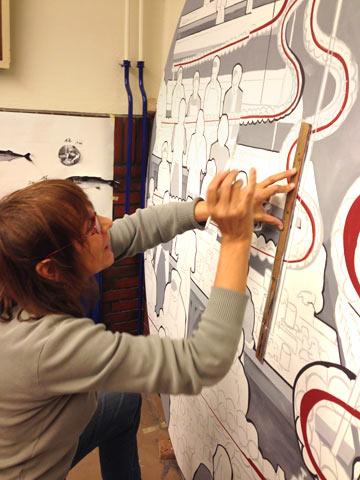
Hildegund Schuster. 2015.
Photo: Elisabeth von Dücker ©
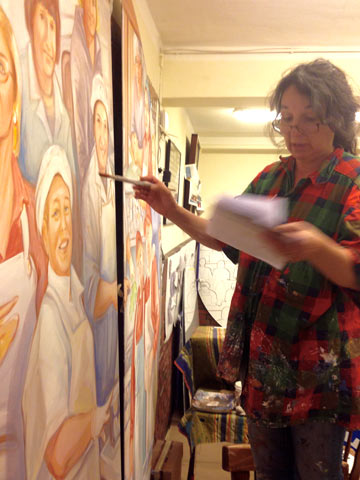
Cecilia Herrero. 2015.
Photo: Elisabeth von Dücker ©
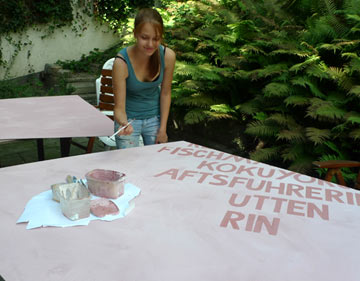
Katharina Moll paints word strips. 2015.
Photo: Hildegund Schuster ©
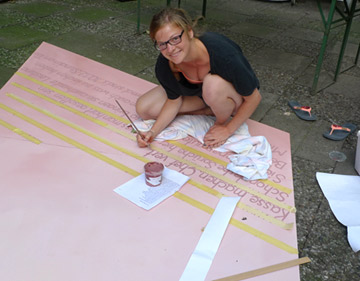
Annika Meier paints interview strips. 2015.
Photo: Hildegund Schuster ©
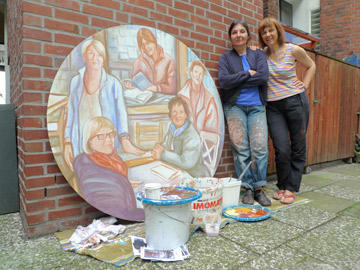
Painters in the garden. 2015.
Photo: Elisabeth von Dücker ©
back to the start of the picture gallery
4. Transport and installation
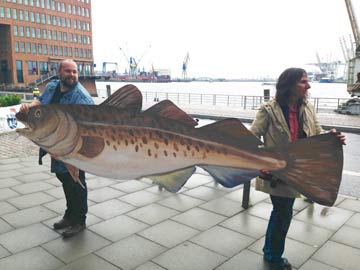
Fiete Sturm and Cecilia Herrero transporting the fish. 2015.
Photo: Elisabeth von Dücker ©
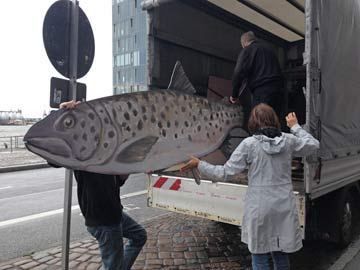
Loading the fish. 2015.
Photo: Elisabeth von Dücker ©
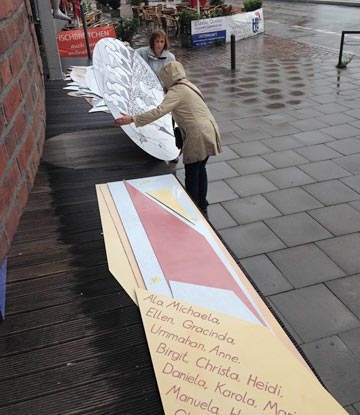
Transport regardless of wind and weather. 2015.
Photo: Elisabeth von Dücker ©
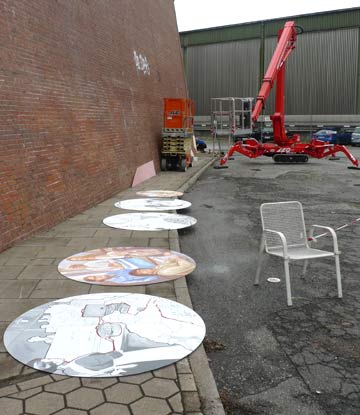
Tondi waiting to be installed. 2015.
Photo: Hildegund Schuster ©
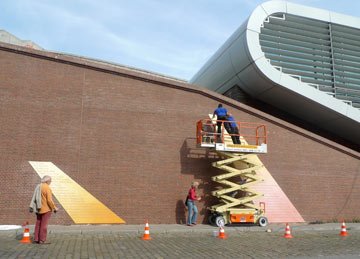
Installation begins. 2015.
Photo: Hildegund Schuster ©
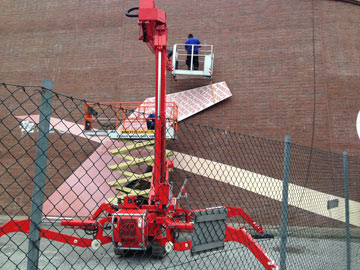
Installation with a cherry picker. 2015.
Photo: Elisabeth von Dücker ©
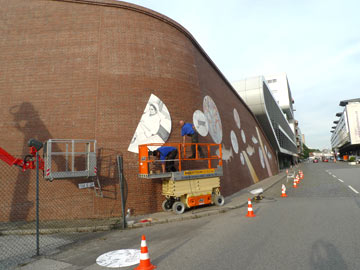
First half of the tondi. 2015.
Photo: Hildegund Schuster ©
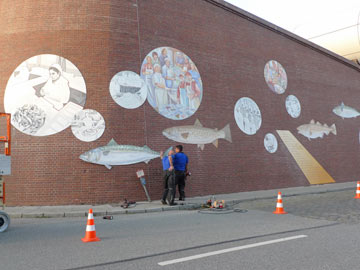
Bending the fish round the curve. 2015.
Photo: Hildegund Schuster ©
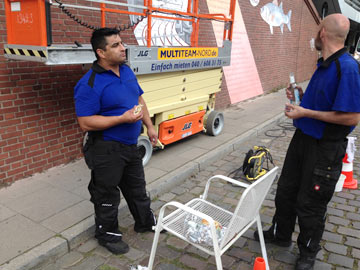
Refreshments with fish rolls. 2015.
Photo: Elisabeth von Dücker ©
back to the start of the picture gallery
5. Inauguration
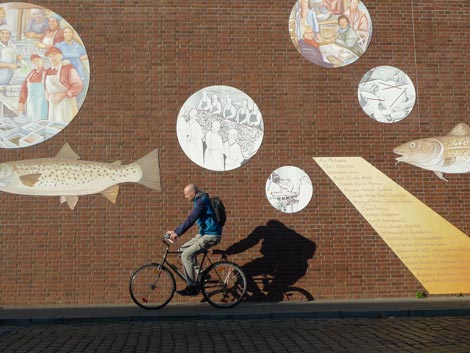
Here come the guests. 2015. - Photo: Hildegund Schuster ©
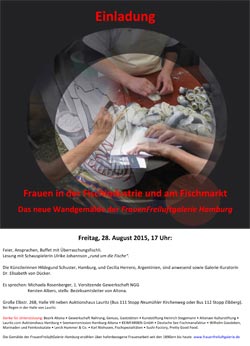
Invitation to the inauguration
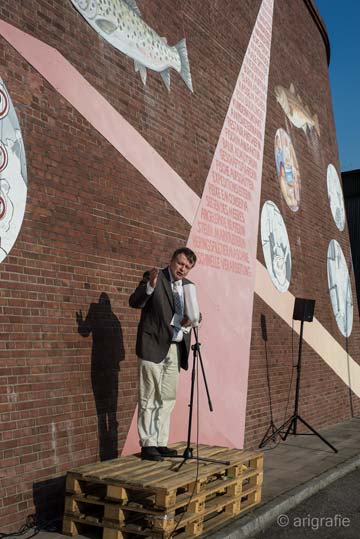
Keynote speaker Kersten Albers, Deputy Head of the District Office Altona 2015.
Photo: arigrafie.de ©
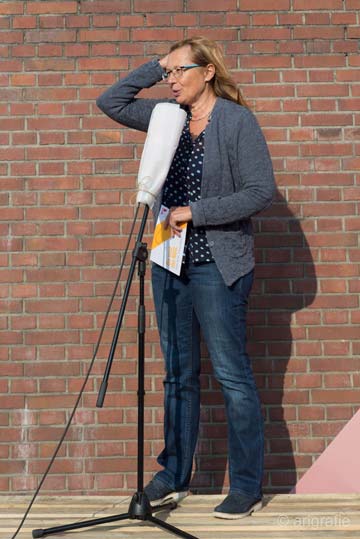
Speech by Michaela Rosenberger, NGG chairwoman
2015. Photo: arigrafie.de ©
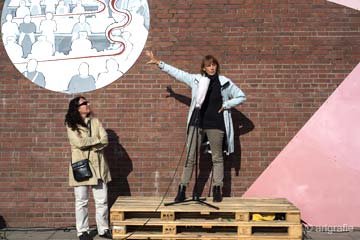
The two painters. 2015.
Photo: arigrafie.de ©

The curator. 2015.
Photo: arigrafie.de ©
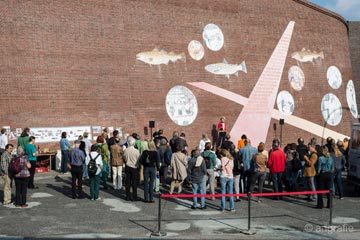
The audience is listening. 2015.
Photo: arigrafie.de ©
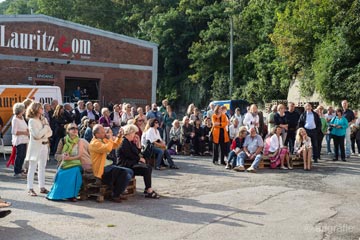
The audience is still listening. 2015.
Photo: arigrafie.de ©
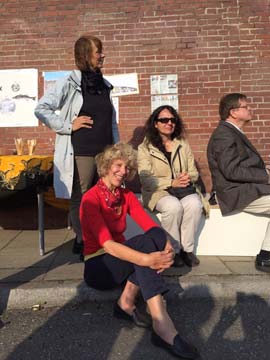
The project team. 2015.
Photo: Reinhardt Reimer ©
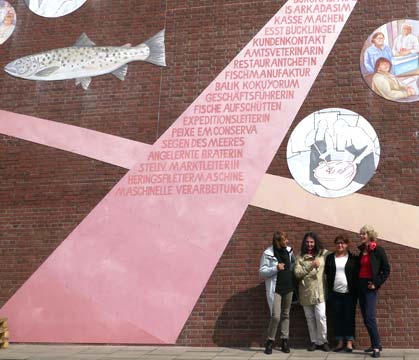
Ummahan with the project team. 2015.
Photo: Reinhardt Reimer ©
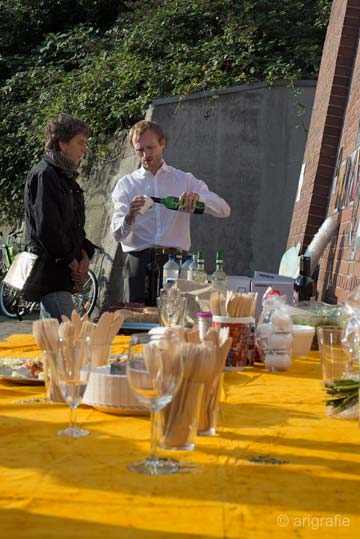
Host Wolfram Schnelle, Auktionshaus LAURITZ.COM on butler duty. 2015. - Photo: arigrafie.de ©
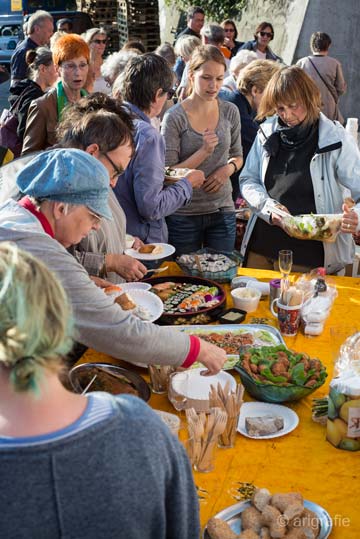
The fish buffet. 2015.
Photo: arigrafie.de ©

Hamide Scheer with the project team. 2015.
Photo: arigrafie.de ©
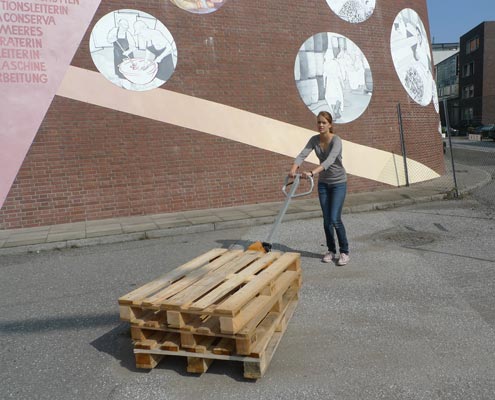
Katharina Moll tidies up afterwards. 2015.
Photo: Hildegund Schuster ©
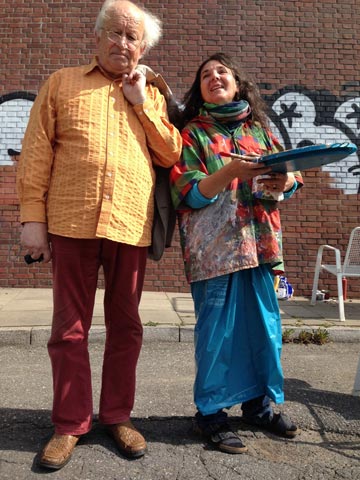
Cecilia Herrero and Günter Zint. 2015.
Photo: Elisabeth von Dücker ©
back to the start of the picture gallery
6. Close-ups
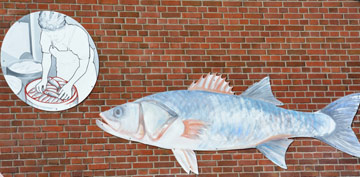
2015. Photo: Klaus Schlegel ©
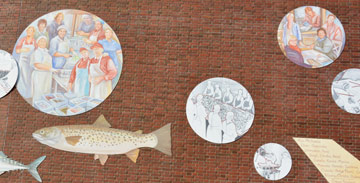
2015. Photo: Klaus Schlegel ©
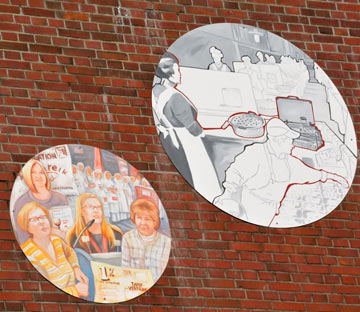
2015. Photo: Klaus Schlegel ©
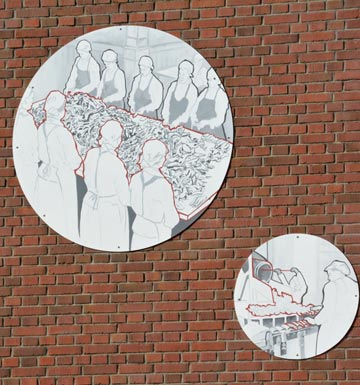
2015. Photo: Klaus Schlegel ©
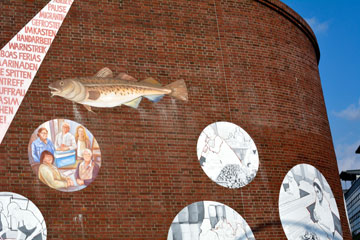
2015. Photo: Klaus Schlegel ©
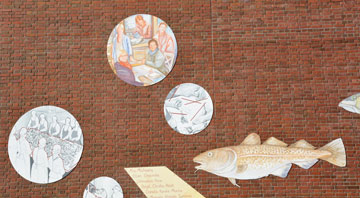
2015. Photo: Klaus Schlegel ©
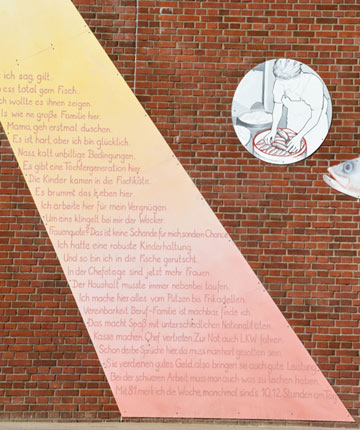
2015. Photo: Klaus Schlegel ©

2015. Photo: Klaus Schlegel ©
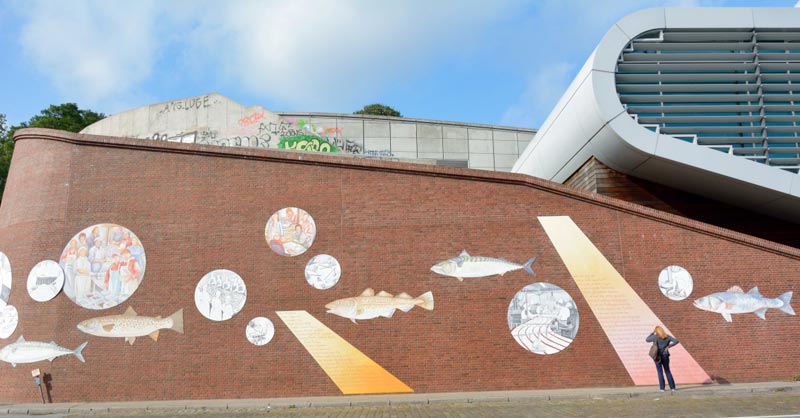
2015. Photo: Klaus Schlegel ©

